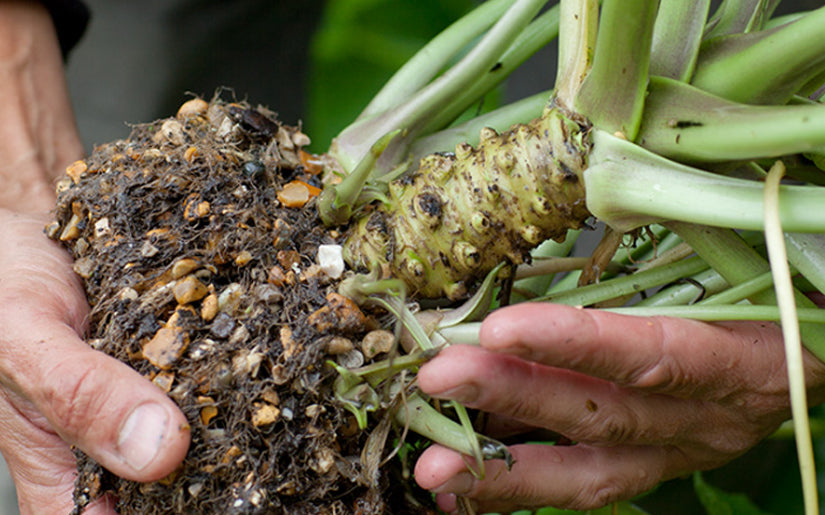
The kit you need
When you receive your wasabi, you’ll quickly realise that you can’t just whack it on your sushi as it is, it’s going to need a bit of careful preparation.
It’s really easy to do, and even simpler with the aid of a couple of inexpensive tools. We have sourced these tools from Japan and are passing them on to you at the best possible price as we feel they are essential if you are going to experience the very best that fresh wasabi has to offer. Buy them here. Although it appears Parmesan style graters will work just as well, the set of teeth on these tools means a lot of your valuable wasabi will be left behind on the grater and it is very hard to remove. Above all it is essential you grate the wasabi into a fine paste to generate the best flavour and the all important, pungent heat.
Preparing fresh wasabi
All orders are sent with our wasabi preparation and storage brochure.
This is your guide to preparing fresh wasabi paste from the revered wasabi rhizome. The rhizome, often mistaken for a root, is a swollen stem that builds height as the leaves grow from the crown of the plant, much like a palm tree.
Follow the instructions below to produce an authentic, fresh wasabi paste with a naturally aromatic, floral flavour backed with the unmistakeable sweet pungency of real wasabi.
After rinsing the rhizome under cold running water, follow these easy steps to preparing your fresh wasabi.
- Peeling is not essential but any dark patches of skin can be removed for a cleaner paste. Remove the stems as shown in the image, this will reveal the greenest, sweetest wasabi; it is here you should start to grate.
- Using a wasabi grater, grate in a circular motion; this effectively advances the wasabi to a fine paste. Keep grating until you have as much as you need. Don’t grate too much in one go as it will lose its flavour after 15 – 20 minutes and you can always grate more.
- Use the brush to remove the wasabi from the grater to a wooden or ceramic surface as a steel surface speeds the oxidisation process. Gather into a ball and let it rest at room temperature for up to 5 minutes for the flavours to develop, then it’s ready to serve.
- If you do not have a wasabi grater it is essential you grate the wasabi into a fine paste to generate the best flavour and the all important pungent heat. Microplane or parmesan graters will help to achieve the paste but some valuable wasabi will be left behind on the teeth of the grater. We do not recommend using a normal cheese grater as you are looking to achieve a much finer paste than these are capable of producing. Wasabi graters are available to purchase from our store.
Wasabi tips
Oka wasabi is the name used to refer to the plant when it is grown in soil; this is considered to be a product of lesser quality and is more commonly used for processing as opposed to fresh consumption. Soil grown wasabi is also more prone to disease
Wasabi flavour & pungency
Wasabi loses its flavour after 20-25 minutes when exposed to the air. Gathering the paste into a ball minimizes contact with air and therefore prolongs the flavour.
You can freshen up wasabi that has been oxidised by grating a little fresh wasabi onto the pile and gathering it up into a ball once more. When cooking with wasabi be careful not to expose it to a direct high temperature as this can compromise both flavour and heat.
Storing fresh wasabi
Rhizomes will store well for two weeks in the plastic bag they were sent in. Keep the bag in the fridge unsealed. Rinse in cold water every 1-2 days for maximum shelf life.
If you want to freeze leftover wasabi, grate it to a paste, wrap in cling film and freeze immediately. When you are ready to use, allow it to de-frost, mix and serve. Whole rhizomes do not freeze well as they lose flavour and pungency.
Love it fresh
Fresh wasabi delivers a clean, aromatic, pungent flavour with a natural sweetness. A stark contrast to the imitation wasabi paste and powders made from horseradish, mustard and additives.
The best sushi, sashimi and noodles deserve real wasabi and experiencing it for the first time sends Japanese cuisine lovers to the next level, determined never to go back to the fake products.
European chefs discovering fresh wasabi are using it in ways it has never been used before. Dishes inspired by these chefs and other recipes can be found on our website.


